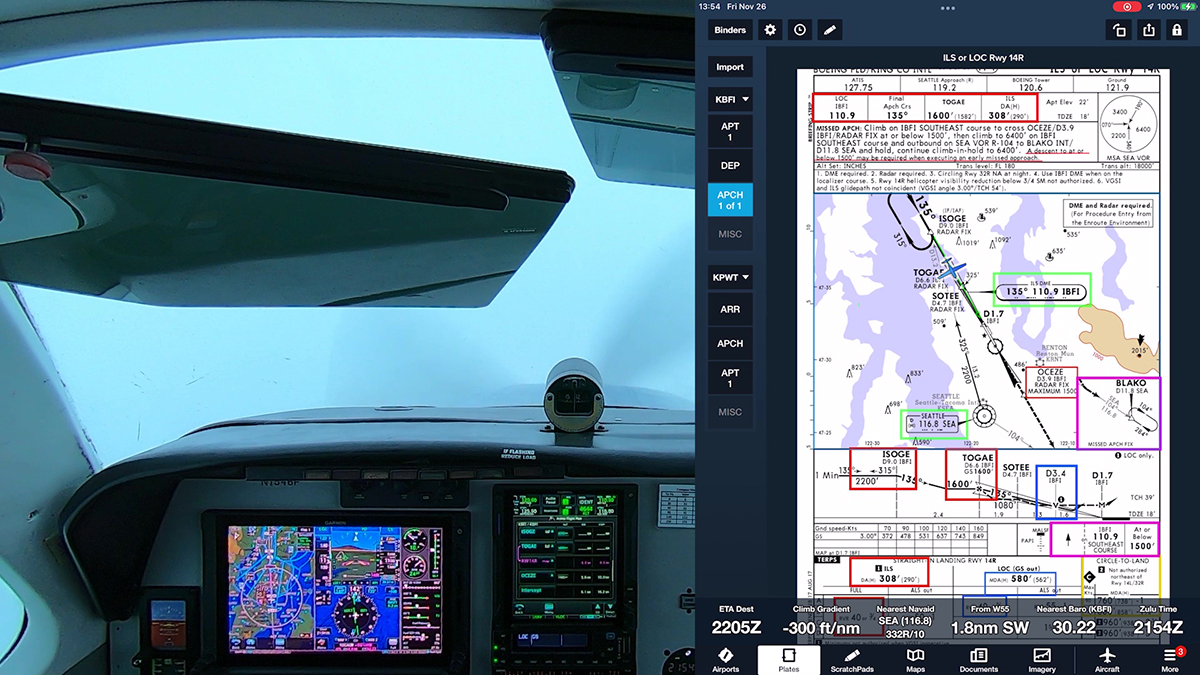You can still fly IFR in the U.S. without an IFR-approved GNSS (i.e., GPS), but being “slant G” (/G in the soon-to-be obsolete FAA domestic flight plan format) increasingly offers advantages, even if you fly only conventional procedures based on ground navaids. And sometimes an IFR-approved GNSS is required to fly even an ILS.
Other examples include the ILS or LOC RWY 28R at Billings, MT (KBIL) and the ILS or LOC RWY 12 at Huron, SD (KHON)
Consider the ILS Z OR LOC Z RWY 16R approach at Reno/Tahoe International Airport (KRNO). This procedure is not an Authorization Required approach–RNP doesn’t appear in the title, and you won’t find that restrictive note on the chart.
For more information about RNP procedures, see RNP Procedures and Typical Part 91 Pilots. To learn about new required equipment notes on FAA charts, see New Equipment Required Notes.

But the equipment required notes for this ILS approach include “RNAV-1 GPS required.”

A review of the plan view and missed approach track show why GPS is necessary to fly this procedure.

First, you need GPS to fly transitions from most of initial fixes, which are RNAV waypoints marked by a star symbol.

Only LIBGE, directly north of the runway, is a non-RNAV IAF.
For example, HOBOA, KLOCK, BELBE, and WINRZ are all RNAV waypoints that serve as IAFs or IFs. Now, NORCAL Approach might provide vectors to the final approach course, but if you want to fly this procedure you should be prepared for a clearance direct to one of those fixes (see Avoiding the Vectors-to-Final Scramble).
Note also that entire missed approach track requires use of GNSS.
Two of the transitions are of special note. The “arcs” that begin at ZONBI and SLABS are radius-to-fix (RF) legs that are part of the transitions that begin at HOBOA and KLOCK. Each of those fixes is distinguished by the notes “RNP-1 GPS REQD” and “RF REQD.”
The first note means that your GPS must meet the RNP 1 standard, which is used for terminal procedures such as SIDs and STARs, the initial phases of approaches, and missed-approach segments. (For more information about RNP, see RNP Procedures and Typical Part 91 Pilots.)
Until recently, RF legs were included only in Authorization Required (AR) procedures. But as I explained in Garmin GTN Avionics and RF Legs, certain RF legs are now available if you have an appropriate GNSS navigator, updated system software, an electronic HSI, and other equipment. Some limitations on flying such RFs also apply, as described in that earlier post.
Suppose that you choose the less intimidating ILS X or LOC X RWY 16R to the same runway. A review of the notes and the plan view shows that even this conventional-looking ILS also requires RNAV 1 GPS, both to fly the transition from WINRZ and the missed approach track.



There is a chart NOTAM for ILS Z. “RNP-1 required” replaces RNAV-1.
The two notes are functionally equivalent for most users. The difference is subtle. See the Satellite Navigation page at the FAA website:
Required Navigation Performance (RNP) is similar to Area Navigation (RNAV); but, RNP requires on-board navigation performance monitoring and alerting capability to ensure that the aircraft stays within a specific containment area.
Are they really functionally equivalent for, e.g., a KLN 89 user or does that requirement mean this approach is now completely off limits for them?
See also AC 90-105 (https://www.faa.gov/regulations_policies/advisory_circulars/index.cfm/go/document.information/documentID/1029146). In that document, n.b. 12.6, A.2.3, and especially A.2.4:
A.2.4 Qualified Avionics Equipment and Airworthiness Approval. Aircraft with the following avionics equipment and an appropriate airworthiness approval automatically qualify for RNP APCH to LNAV minima capability without further documentation by virtue of the avionics Technical Standard Order (TSO) and airworthiness approval:
1. GPS stand-alone systems approved in accordance with TSO-C129( ), Class A1, or TSO-C146 operational Class 1, 2, or 3 and installed in accordance with AC 20-138( ).
AC 90-105 seems to deal with RNP-APCH. The approach chart calls for RNP-1. They are similar, I believe, but it’s still not obvious whether a KLN 89 satisfies RNP-1 or not.
RNP-APCH is the basic standard. The AC isn’t easy to parse, but the sections I referenced are clear that an IFR approved GPS under TSO 129 like the KLN 94 meets the requirements. Reviews those sections and the AFM supplement that came with your KLN94 installation.
You need to review the AFM supplement that accompanies your KLN94 to determine what your unit allows as it’s installed in your aircraft.
I don’t have a KLN 94 but I know people who do. Pretty sure RNP-1 and RNP-APCH didn’t exist when the AFM supplement was written.
Yes, but the TSO 129 under which they were certified did, and AC 90-105 explains RNP-APCH and how it relates to the units certified under old rules.
Again, see A.2.4 of that document:
Qualified Avionics Equipment and Airworthiness Approval. Aircraft with the following avionics equipment and an appropriate airworthiness approval automatically qualify for RNP APCH to LNAV minima capability without further documentation by virtue of the avionics Technical Standard Order (TSO) and airworthiness approval:
1. GPS stand-alone systems approved in accordance with TSO-C129( ), Class A1, or TSO-C146 operational Class 1, 2, or 3 and installed in accordance with AC 20-138( ).
Your AFM supplement will list limitations on using your GNSS navigator under IFR, and those limitations still apply.
You can also refer to the AC 90-100 Compliance document available at the FAA website here. See specifically p. 68 of that PDF (or better search for “KLN 89”) for information the KLN 89 compliance with PBN standards.